Homemade Sourdough Bagels – With Video
Sourdough bagels are chewy, crusty and properly dense. They have an extra deep flavor thanks to the sourdough starter in the recipe. This recipe take more than 12 hours to make, but the vast majority of the time is hands-off.

I’ve said it before, I think a good bagel should have a nicely dense and chewy texture with a toothsome crust. Forget the frozen hockey pucks from the grocery store, and the bagels from chain bakeries that are way too fluffy to be a real bagel.
Homemade bagels are not hard to make and they freeze beautifully. If you set aside a little time over a weekend, you can stock up the freezer for weeks to come.
This Sourdough Bagel recipe is a variation of my popular recipe for New York Style Bagels.
If you don’t already have one, I can show you how to make a sourdough starter and how to feed a sourdough starter.
Ingredients
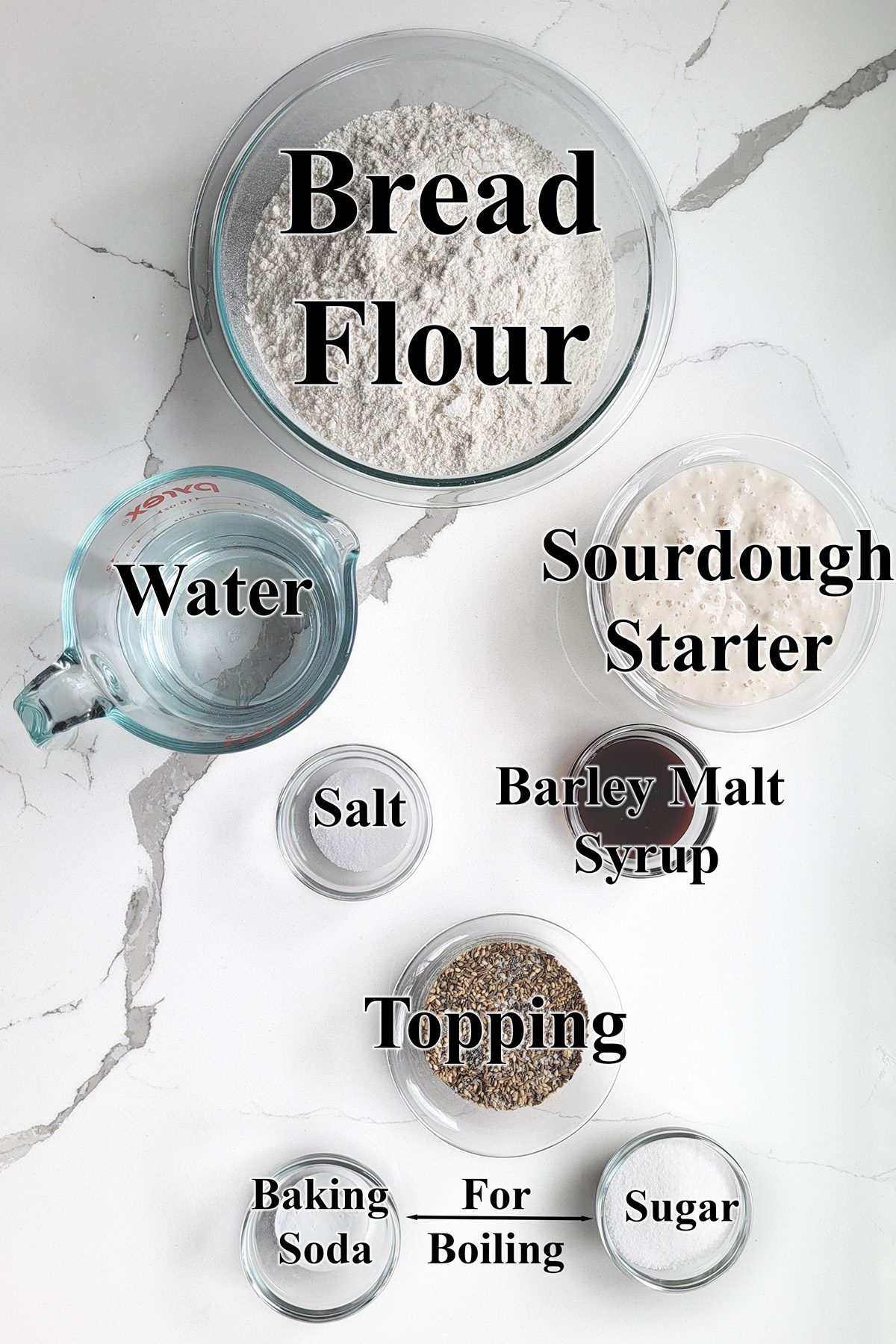
Ingredient Notes
- Bread Flour – Bagels should have a very chewy crumb from a strong gluten network in the dough. High protein bread flour develops plenty of gluten.
- Sourdough Starter – The recipe was developed using 100% hydration starter. You will need to adjust the liquid or flour in the recipe if you’re starter isn’t at 100% hydration. Your starter should be fed and active when you mix the bagel dough.
- Barley Malt Syrup – Adds a traditional slightly sweet note to the dough. You can substitute honey or a combination or honey and molasses for the barley malt syrup.
- Toppings – Leave the bagels plain or use your favorite seed for topping. You can mix seeds with salt to make your own “everything” bagel topping”. See the recipe card for details.
- Baking Soda & Sugar – For boiling the bagels. The boiling process creates the specific shiny and chewy bagel crust.
Process photos for making Sourdough Bagels
See the recipe card for detailed measurements and instructions.
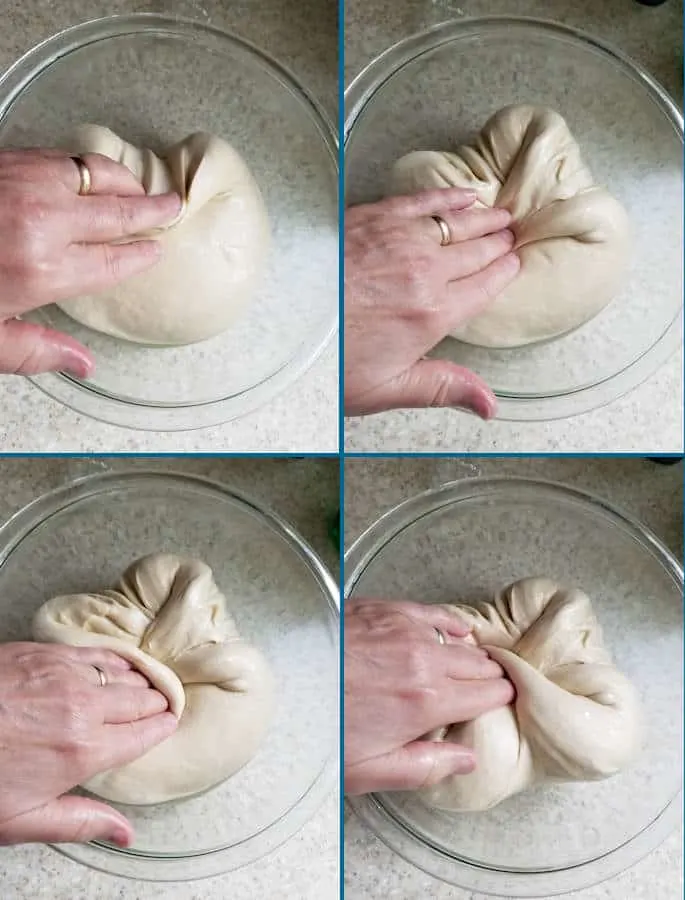
- As the dough ferments, it should be folded onto itself every hour or so to redistribute the yeast.
- Fold from each side into the middle, then flip the dough over.
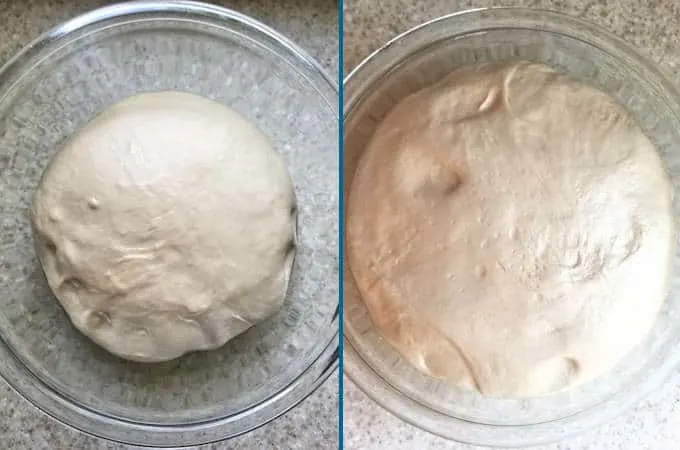
- After 30 minutes there’s not much activity in the dough (left).
- After 3 hours the dough should be active and nicely aerated (right).
- After fermentation it’s time to shape the bagels.
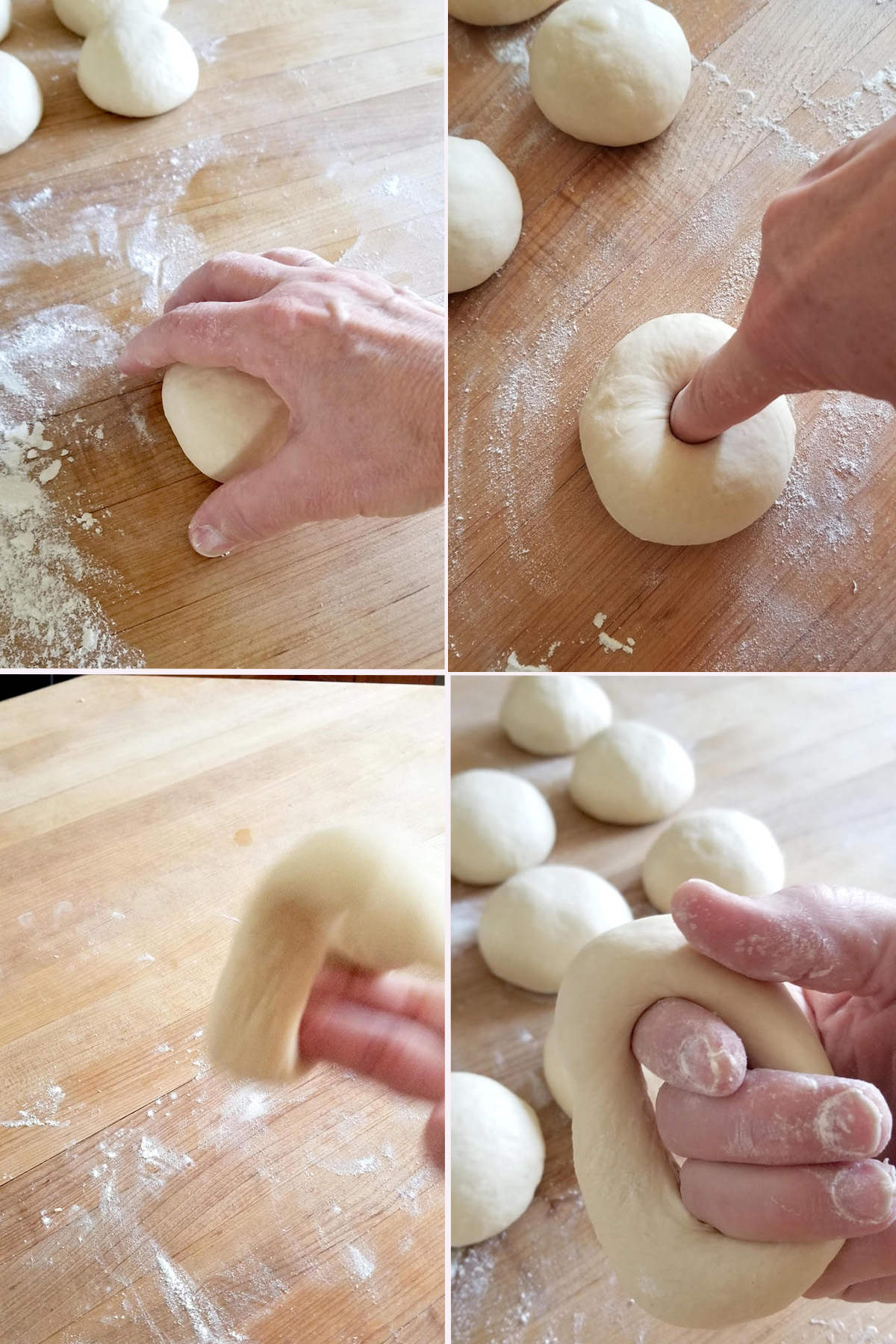
- Use a cupped hand to form the a piece of dough into a tight ball. Repeat with all the pieces of dough.
- Poke your finger all the way through the center of the ball to make a hole.
- Twirl the dough around your fingers to widen the center hole.
- Set the bagel onto the baking sheet and continue with the rest of the dough.
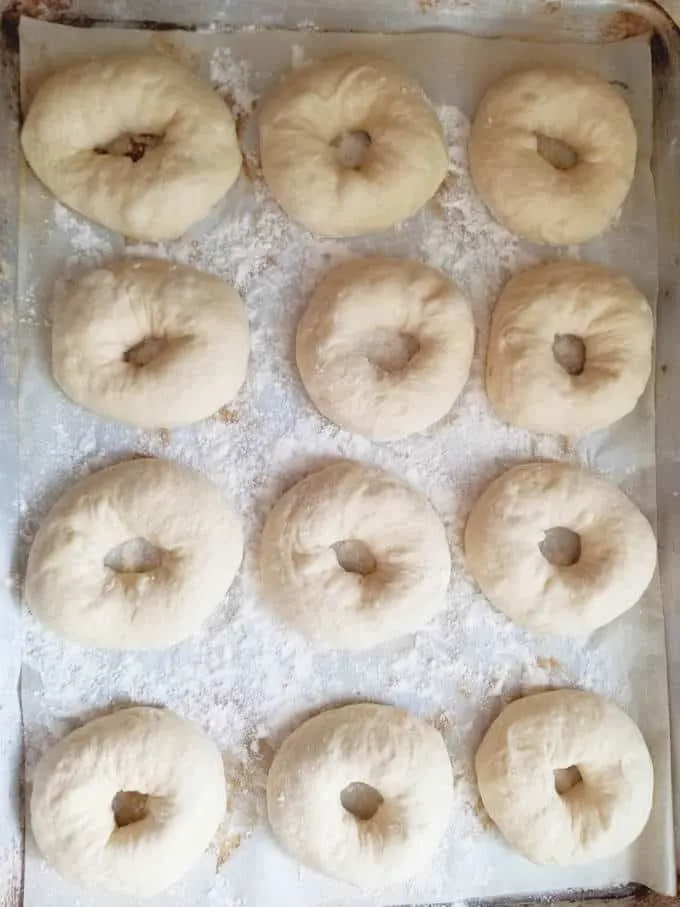
- Line the formed bagels onto a well-floured (or use cornmeal) sheet pan to prevent sticking.
- Cover the pan and place it in the refrigerator overnight.
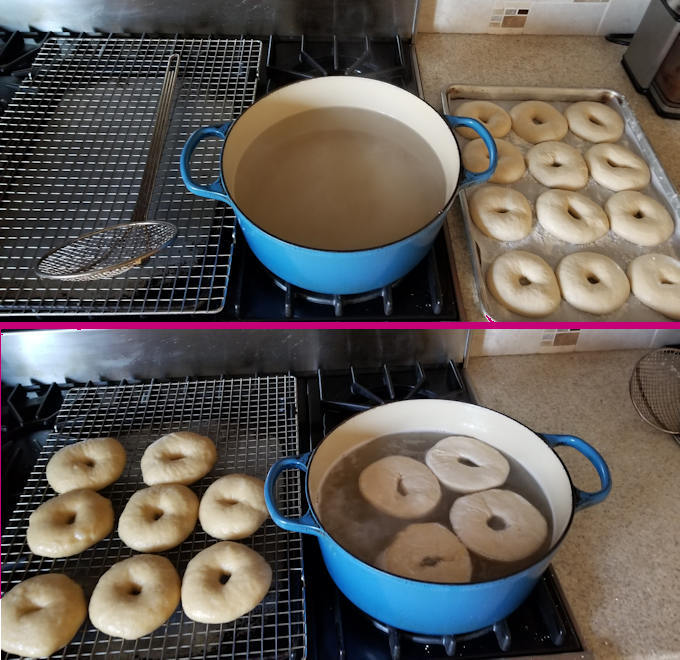
- Bring a pot of water with baking soda and sugar to a boil. Preheat the oven.
- Boil the bagels a few at a time, flipping them every thirty seconds. Boil each batch for 2 minutes.
- Transfer the bagels to a rack to drain while you finish boiling the rest of the bagels.
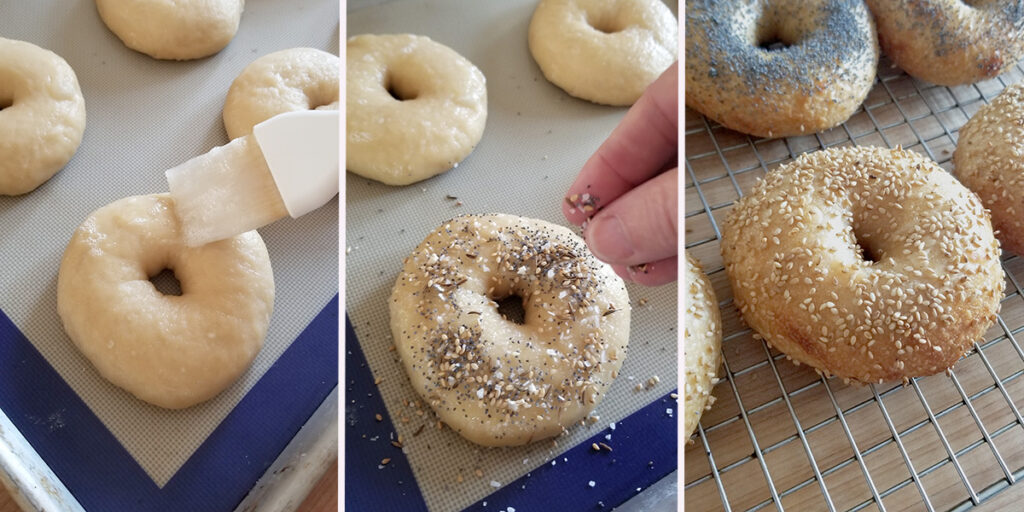
- Brush the boiled bagels with egg white.
- Sprinkle seeds or bagel topping if desired.
- Bake until the bagels are golden brown.

Recipe Tips
- Make sure your starter is very active and lively. I get the best results when I do two feedings in the days before making this dough. I keep several starters and use the Small Starter for this recipe because it requires two feedings before baking with it.
- To get a good bagel shape that will rise properly, you must create a tight ball of dough before making the ring. Use a cupped hand and surface friction to roll the dough into a ball. You can see how it’s done in the recipe video.
- Place the shaped bagels on sheet pan which has been sprinkled liberally with cornmeal or flour. If the bagels stick to the pan you will loose volume when transferring them to the water. I find cornmeal works best, but flour will work too.
- In the morning, take the bagels out of the fridge and leave them out until the dough comes to room temp.
- Don’t start boiling the bagels until the oven is preheated. They should go into the oven within minutes of coming out of the water.
Storage
- Bagels are best the day they are baked. For longer term storage, slice the bagels about 3/4 the way through and pack them into freezer bags.
- Previously frozen bagels are best if toasted before serving.
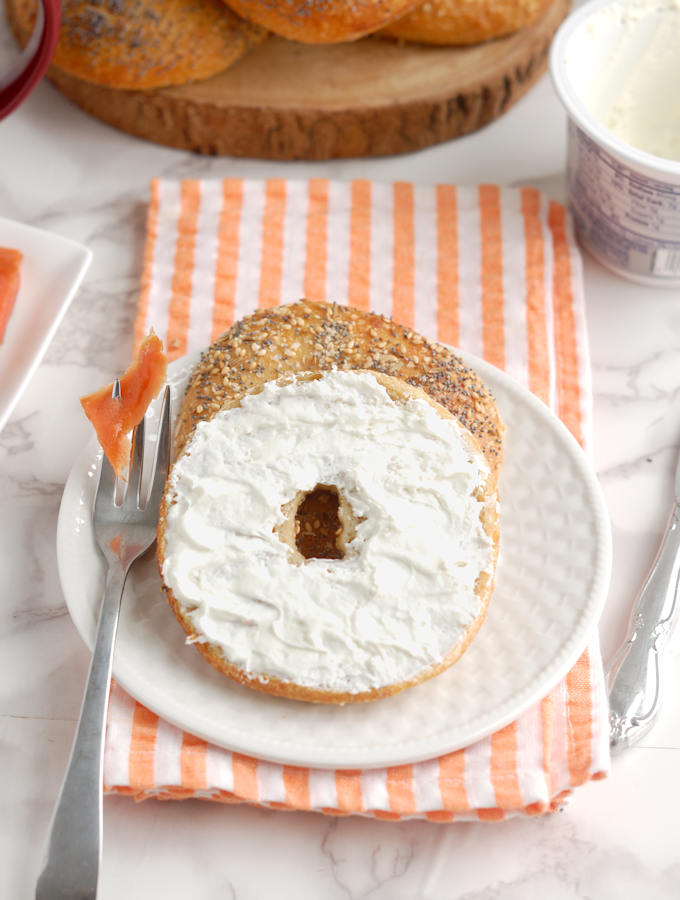
I know you hate to throw away that sourdough discard. Check out these recipes that use sourdough discard.
If you love this recipe as much as I do, please consider giving it a 5-star review.
Sourdough Bagel Recipe
Ingredients
- 8 oz active sourdough starter (1 cup (100% hydration))
- 12 oz warm water (1 ½ cups)
- 22 ½ oz bread flour (4 ½ cups, divided, see note)
- 1 ½ oz barley malt syrup (2 tablespoons (or honey + molasses))
- 1 tablespoon table salt
- 2 oz granulated sugar (¼ cup (for boiling))
- 2 teaspoons baking soda (for boiling)
- corn meal (for pan prep)
- 1 egg white (whisked lightly)
- Topping (sesame seeds, poppy seeds, caraway seeds or coarse salt)
Instructions
- Combine 8 oz active sourdough starter, 12 oz warm water and 2 cups (10 oz) of the flour in a mixing bowl. Mix to form a thick batter. Cover the bowl and set aside for 30-60 minutes.
- Add 1 ½ oz barley malt syrup and 1 tablespoon table salt. Switch to the dough hook. Add the remaining 2 ½ cups (12 ½ oz) flour and mix to combine. The dough should eventually cling to the hook and start to clear the sides of the bowl.
- Knead 5 minutes on medium speed. If working by hand, stir in as much of the flour as you can, then turn the dough out onto a lightly floured surface and knead in the remaining flour. Knead 5 minutes. Form the dough into a smooth ball.
- Put the dough into a lightly oiled bowl, turning once to coat the dough. Cover the bowl and set it aside at room temperature. After 30 minutes uncover the bowl, lift one side of the dough and fold it into the middle of the dough. Repeat with the other three sides of the dough then flip the dough over. You're basically turning the dough inside-out to redistribute the yeast. Cover the bowl and repeat the procedure every 60 minutes for a total fermentation time of about 3 hours. The dough should be lively, elastic and airy. If the dough is still sluggish give it another hour or two at room temperature.
- Line a baking pan with parchment paper then generously sprinkle the paper with cornmeal (or flour). Turn the dough out onto a lightly floured surface without kneading out the air. Divide the dough into 10 even pieces. Use a cupped hand to roll each piece into a smooth, tight ball.
- To form a bagel, poke your finger all the way through the center of a ball to make a hole. Use two fingers to gently open up the hole. Continue gently stretching to form the bagel or twirl the dough around your fingers to widen the center hole to 1 – 1½" wide.
- Place the bagel on the prepared sheet pan and continue to form the remaining bagels. The dough will probably spring back a bit so you can go back and re-stretch the holes once you're done forming all the bagels. Cover the pan with plastic wrap. If the dough and the ambient temperature is on the cooler side, leave the shaped bagels at room temperature for 30 minutes then place the pan in the refrigerator overnight. If the dough and ambient temp is warmer and the dough is quite active, place the bagels into the refrigerator without leaving them out for 30 minutes.
- In the morning take the bagels out of the refrigerator and bring them to room temperature.
- Preheat the oven to 450 °F. In a large pot combine 1 gallon of water with 2 oz granulated sugar and 2 teaspoons baking soda and bring it to a boil. Reduce the heat to keep the water at a rolling simmer. Set a cooling rack over a sheet pan or kitchen towel and place it next to the stove. Line two half-sheet pans with parchment paper or silicone baking mats and generously sprinkle with corn meal.
- Once the oven is preheated, you're ready to boil. Gently lift a bagel off the sheet pan and lower it into the water, bottom side down. Depending on the size of your pot, you can boil 3-4 bagels at a time. Boil the bagels for 30 seconds then flip them. Boil the other side for 30 seconds. Repeat the process again for a total of 2 minutes boiling time. Remove the boiled bagels from the water and set them on the cooling rack to drain.
- Place 5 of the boiled bagels on each sheet pan. You could fit them all on one pan but they may stick together as they bake.
- Brush the bagels with egg white. Add the topping(s) of your choice. To make "everything" bagels combine a tablespoon of each of sesame seeds, poppy seeds & salt with a 1/8 teaspoon garlic powder and onion powder. Bake until golden brown, about 20 minutes.
Would you like to save this recipe?
As an Amazon Associate and member of other affiliate programs, I earn from qualifying purchases.









Hi, do you HAVE to put them in the fridge overnight ?
Hi Lea, You don’t have to. The longer, cooler rise in the refrigerator does good things for the flavor and texture of the bagels. I also like the convenience of working the day before to have hot bagels for breakfast. That being said, you can skip the refrigerator step and just leave them at room temp to rise, then boil and bake.
Wish I could post a photo of these bagels! They are wonderful! My family was beyond thrilled as we recently moved from Brooklyn to CT and can’t find a decent bagel around. This recipe is a keeper for sure! I used a combo of molasses and honey in place of barley malt.
Thanks, Kasum. Please feel free to post a photo on social media, if you do social media. You can tag @bakingsenseblog on Facebook or eileen.bakingsense on Instagram.
Great chewy bagels. Great flavor. They all were eaten the first night.
Mine rose more horizonrtally than vertically. Any suggestions?
Hi Andrea. Did you use bread flour and knead the full 5 minutes? If they spread out more than up I would guess the gluten wasn’t quite strong enough. This dough should be pretty elastic by the time you’re forming the bagels. If you start forming the bagels and the dough isn’t springing back a bit I would try rolling each bagel into a rope and then bring the ends together to form the loop. The extra work on the dough might give it that extra strength.
Tried making these for the first time. After sitting overnight in the fridge they had not risen at all in fact they looked flat. So I put them in my oven with a pot of boiling water to help them rise. I got my water ready and went to pick them up to put them in the water and they deflated. Wondering what i can do to prevent this from happening. I had placed the dough on parchment paper. Should it be heavily floured or oiled to keep the dough from sticking?
Hi Amy. Did you let the shaped bagels sit at room temperature for 30 minutes before putting the tray in the fridge for the night? This gives them a bit of a head-start on rising over night. But I’ve also put the shaped bagels immediately in the refrigerator and they still rose during the night. Was your starter very active and was the dough active during fermentation? What I do to jump start the cold dough in the morning is I turn on the oven just long enough to get it barely warm. Then I put the tray in the oven. If you warmed the oven with a pot of boiling water you probably created a very moist environment. I’m guessing this made the shaped bagels more sticky so they stuck to the pan and deflated when you picked them up. Yes, as instructed in the recipe you should flour the parchment paper to prevent the bagels from sticking as they rise. In the future I would try creating a warm oven by briefly turning it on instead of using the boiling water. Also, as with any bread dough, if you find that it’s over-risen and/or deflated you can reshape and re-rise the dough. It’s a bit of a set-back but it can save a deflated bread.
Hi Amy in her instructions she forgot to say when to add sugar and baking soda. That may have been the reason.
Hi Shawna. The sugar and baking soda are not added to the dough. They go into the water as instructed in step #9. I did add a comment “for boiling” on those ingredients to help alleviate any confusion.
I made these 2 days ago and they’re almost gone!! I followed the recipe pretty well but I had to add more flour for my dough to pick up off the bowl at the beginning. Also I had to leave the shaped circles out longer than 30 minutes for them to rise. The result was a very delicious bread however it wasn’t dense like a bagel. Also I think because it sat at room temperature for a while before I boiled the dough I couldn’t keep the shape nice so it was very irregular. Not sure how I can improve in the future. I’ll definitely try again.
These turned out perfect!! A great quarantine distraction. I put cheddar cheese on one to bake in the oven and made the rest everything bagels and they all look and taste amazing.
Sorry didn’t mean for that to be a reply, just a separate comment 🙂
I had the same problem, tasty, but not the right texture. The dough stayed sticky, even with added flour and never seemed elastic enough. I bake a couple times a week with my starter and never have this issue. Usually sourdough is wonderfully bouncy and chewy.
Did you watch the video? You can see how the texture of the dough changes during fermentation. I make these bagels almost every week and they are very elastic and have a great texture. If you bake sourdough bread with just flour, water and salt it will be quite a different texture than this recipe with malt syrup added.
Where is the video? I have read through this post several times and cannot find it. My dough is incredibly sticky, even with added flour, and I can’t figure out what went wrong since I bake with sourdough every week.
If you are using an ad blocker the video won’t play. If you turn off the ad blocker you should see the video. The dough still start out quite sticky but will become more cohesive during the fermentation.